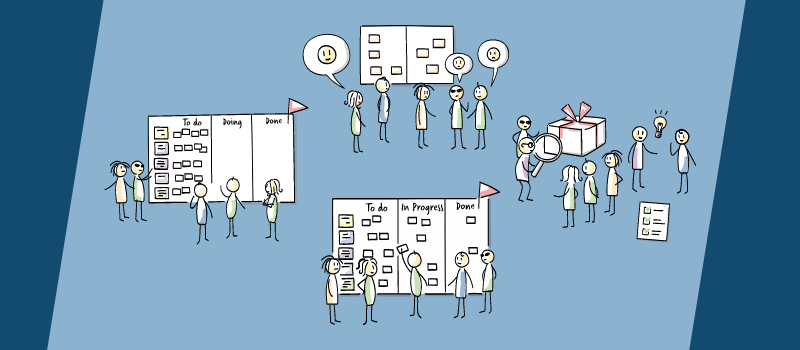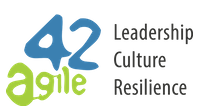
What is Scrum?
In a single sentence, Scrum is a lightweight framework that helps teams and organizations generate value and is based on transparency, inspection, and adaptation. It is being adopted in many domains beyond software product development, where it has its roots.
Scrum works only in its entirety. Each element of the framework serves a specific purpose that is essential to the overall value and results realized. Leaving out elements or not following the rules of Scrum at best limits the benefits and at worst renders it useless.
Learn more about Scrum basics in our online short course, Scrum Foundations
Scrum Values
Successful use of Scrum depends on people becoming more proficient in living five values:
- Commitment
- Focus
- Openness
- Respect
- Courage
These values give direction to the team with regard to their work, actions and behavior. The decisions that are made, the steps taken, and the way Scrum is used should reinforce these values, not diminish or undermine them. The team members learn and explore the values as they work with the Events and Artifacts (more on these below). When these values are embodied by the Scrum Team and the people they work with, the pillars of transparency, inspection, and adaptation come to life and help build trust.

The Scrum Team
The Scrum Team represents the fundamental unit of Scrum and consists of one Product Owner, one Scrum Master, and Developers. It is important to clarify that Scrum Master, Product Owner and Developers are all equal parts of one team. Within a team, there are no sub-teams or hierarchies. It is a cohesive unit of professionals focused on one objective at a time, the Product Goal. The entire Scrum Team is accountable for creating a valuable, useful Increment every Sprint. However Scrum defines the following specific accountabilities within the Scrum Team:
- The Product Owner is customer-facing, accountable for the prioritization of work and maximizing customer value, which can be summarized as “doing the right things”.
- The Developers have all skills necessary to create a valuable Increment each Sprint, and are self-managing to “do the things right”.
- The Scrum Master is accountable for establishing Scrum and increasing the team’s effectiveness by enabling continuous improvement, often summarized as “getting better”.
The Scrum Team’s primary focus is to make the best possible progress toward the Sprint goal. The team and its stakeholders should be open and communicative about the work and the challenges. Team members should respect each other and trust one another to be capable, independent people. They should be empowered to have the courage to do the right thing and to work on tough problems.
Scrum Artifacts
There are three Scrum artifacts and related commitments, and their purpose is to provide sets of information to the team and stakeholders, including the goal, steps toward achieving the goals, and actions taken to achieve it. They are designed to maximize transparency and allow for regular inspection and adaptation.
Product Backlog and Product Goal
The Product Backlog is an emergent, ordered list of what is needed to improve the product or service. Items in the Product Backlog are refined until they are ready for selection in a Sprint Planning event.
Product Backlog refinement refers to the act of breaking down and further defining items into smaller, more precise items. Another element of the Product Backlog is the Product Goal which describes a future state of the product which can serve as a target for the team to plan against. The rest of the Product Backlog emerges to define what will fulfill the Product Goal.
Sprint Backlog and Sprint Goal
The Sprint Backlog is composed of the Sprint Goal, the Product Backlog items selected for the Sprint, as well as an actionable plan for delivering the Increment. It is a highly visible picture of the work that the Developers plan to accomplish during the Sprint in order to achieve the Sprint Goal and is updated throughout the Sprint as the Developers learn. The Sprint Goal is the single objective for the Sprint.
Although the Sprint Goal is a commitment by the Developers, it provides flexibility in terms of the exact work needed to achieve it. The Sprint Goal also creates coherence and focus, encouraging the Scrum Team to collaborate closely.
Increment and Definition of Done
An Increment is a concrete stepping stone toward the Product Goal. Each Increment is added to all prior Increments and thoroughly tested, ensuring that all Increments work together. The Increment is presented at the Sprint Review. However, it may be delivered to stakeholders prior to the end of the Sprint.
The Definition of Done is a description of the state of the Increment when it meets the quality measures required for the product. Work cannot be considered part of an Increment unless it meets the Definition of Done. Whenever a Product Backlog item meets the Definition of Done, an Increment is born.
Scrum Events
The framework combines Scrum Events for inspection and adaptation within the context of the Sprint. The Sprint itself is considered a Scrum Event.

The Sprint
Sprints are the heartbeat of Scrum, where ideas are turned into value. They are fixed length events of one month or less. A new Sprint starts immediately after the conclusion of the previous Sprint. All the work necessary to achieve the Product Goal happens within Sprints.
Sprint Planning
Sprint Planning initiates the Sprint by laying out the work to be performed during the Sprint. The team collaborates to define a Sprint Goal that communicates why the Sprint is valuable to stakeholders. Through discussion with the Product Owner, the Developers select items from the Product Backlog to include in the current Sprint. Selecting how much can be completed within a Sprint may be challenging.
Watch the Sprint Planning Webinar
However, the more the Developers know about their past performance, their upcoming capacity, and their Definition of Done, the more confident they will be in their Sprint forecasts. For each selected Product Backlog item, the Developers plan the work necessary to create an Increment that meets the Definition of Done. This is often done by decomposing Product Backlog items into smaller work items of one day or less.
Daily Scrum
The purpose of the Daily Scrum is to inspect progress toward the Sprint Goal and adapt the Sprint Backlog as necessary, adjusting the upcoming planned work. The Daily Scrum is a 15-minute event for the Developers of the team. The Developers can select whatever structure and techniques they want, as long as their Daily Scrum focuses on progress toward the Sprint Goal and produces an actionable plan for the next day of work. This creates focus and improves self-management. Daily Scrums improve communications, identify impediments, promote quick decision-making, and consequently eliminate the need for other meetings.
Related reading: Three signs your Daily Scrum sucks (and how to fix it)
Watch the Daily Scrum webinar
Sprint Review
The purpose of the Sprint Review is to inspect the outcome of the Sprint and determine future
adaptations. The Scrum Team presents the results of their work to key stakeholders and progress toward the Product Goal is discussed. During the event, the Scrum Team and stakeholders review what was accomplished in the Sprint and what has changed in their environment. Based on this information, attendees collaborate on what to do next. The Product Backlog may also be adjusted to meet new opportunities. The Sprint Review is a working session and the team should avoid limiting it to a presentation.
Watch the Sprint Review webinar
Sprint Retrospective
The purpose of the Sprint Retrospective is to plan ways to increase quality and effectiveness. The team inspects what went well during the Sprint, what problems it encountered, and identifies the most helpful changes to improve its effectiveness. The most impactful improvements are addressed as soon as possible. They may even be added to the Sprint Backlog for the next Sprint. The Sprint Retrospective concludes the Sprint.
Watch the Sprint Retro webinar
The Scrum Guide
The Scrum Guide is the official document that defines the framework. It was revised by its creators Ken Schwaber and Jeff Sutherland in November 2020 to be less prescriptive and easier to understand and adopt.
Benefits of Scrum
The framework has a number of major benefits when implemented correctly:
- Tasks will be achieved faster and with higher quality
- There will be a high level of self-motivation of the team
- The customer demands will be iteratively prioritized and quickly realized.
Scrum certifications
There are a number of courses that can help you gain the skills, experiences and qualifications you need to continue your journey. Here are some of the key certifications, all offered by agile42 both in-person (depending on your location) and remotely.
View the 2023 Scrum courses schedule
- Certified Scrum Master (CSM)
- Advanced Certified Scrum Master (A-CSM)
- Certified Scrum Professional-Scrum Master (CSP-SM)
- Certified Scrum Product Owner (CSPO)
- Advanced Certified Scrum Product Owner (A-CSPO)
- Certified Scrum Developer (CSD)

Online courses
Perhaps you’re not ready to dive into the more formal qualifications just yet, or you need a refresher or a knowledge update to get up to speed with the current Scrum guide. In these cases, an online short course is a great option. At agile42 we offer the following Scrum online courses:
- Scrum Foundations
- Facilitating Scrum
- Product Ownership Foundations
- Facilitating Retrospectives
- Team Dynamics Foundations
- Agile Roles and Capabilities
Need help implementing Scrum properly? Contact us using the form below for information about our coaching, support and mentoring services:
Scrum webinars for further learning
- In the Product Backlog webinar, agile42 coach Magnus Kollberg describes how to create and maintain a good Product Backlog. He also talks about some of the challenges and pitfalls.
- In the webinar What makes a good ScrumMaster?, agile42 coaches describe what are the qualities and characteristics that make up a good Scrum Master.
- Get to grips with the Scrum Events by watching the Sprint Planning Webinar, Sprint Review Webinar, Daily Scrum Webinar, or Sprint Retrospective Webinar.
